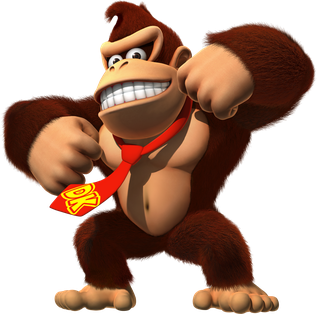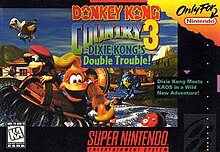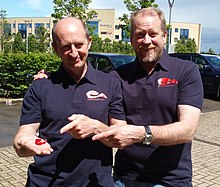
Donkey Kong, also shortened to DK, is a fictional gorilla-like character in the Donkey Kong and Mario franchise, created by Shigeru Miyamoto. The original Donkey Kong first appeared as the title character and antagonist of the eponymous 1981 game, a platformer by Nintendo, which would lead to the Donkey Kong series. The Donkey Kong Country series was launched in 1994 with a new Donkey Kong as the protagonist. This version of the character persists as the main one up to today. While the 1980s games' Donkey Kong and the modern Donkey Kong share the same name, the manual for Donkey Kong Country and subsequent games portray the former as Cranky Kong, the latter's grandfather, with the exception of Donkey Kong 64 and The Super Mario Bros. Movie, in which Cranky is depicted as his father, alternatively portraying the modern Donkey Kong as the original Donkey Kong Jr. from the titular game. Donkey Kong is considered one of the most popular and iconic characters in video game history.

Super Mario World 2: Yoshi's Island is a 1995 platform game developed and published by Nintendo for the Super Nintendo Entertainment System (SNES). The player controls Yoshi, a friendly dinosaur, on a quest to reunite baby Mario with his brother Luigi, who has been kidnapped by Kamek. Yoshi runs and jumps to reach the end of the level while solving puzzles and collecting items with Mario's help.

Donkey Kong Country is a 1994 platform game developed by Rare and published by Nintendo for the Super Nintendo Entertainment System (SNES). It is a reboot of Nintendo's Donkey Kong franchise and follows the gorilla Donkey Kong and his nephew Diddy Kong as they set out to recover their stolen banana hoard from the crocodile King K. Rool and his army, the Kremlings. The player traverses 40 side-scrolling levels as they jump between platforms and avoid obstacles. They collect items, ride minecarts and animals, defeat enemies and bosses, and find secret bonus stages. In multiplayer modes, two players work cooperatively or race.

Donkey Kong Country 2: Diddy's Kong Quest is a 1995 platform game developed by Rare and published by Nintendo for the Super Nintendo Entertainment System (SNES). It was released on 21 November 1995 in Japan, 4 December in North America, and 14 December in Europe. It is the second installment of the Donkey Kong Country series and the sequel to Donkey Kong Country (1994).

Donkey Kong Land is a 1995 platform game developed by Rare and published by Nintendo for the Game Boy. It condenses the side-scrolling gameplay of the Super Nintendo Entertainment System (SNES) game Donkey Kong Country (1994) for the handheld Game Boy with different level design and boss fights. The player controls the gorilla Donkey Kong and his nephew Diddy Kong as they defeat enemies and collect items across 30 levels to recover their stolen banana hoard from the crocodile King K. Rool.

Donkey Kong 64 is a 1999 platform game developed by Rare and published by Nintendo for the Nintendo 64. It is the only Donkey Kong game to feature 3D gameplay. As the gorilla Donkey Kong, the player explores themed levels to collect items and rescue his kidnapped family members from King K. Rool. The player completes minigames and puzzles as five playable Kong characters—each with their own special abilities—to receive bananas and other collectibles. In multiplayer modes, up to four players can compete in deathmatch and last man standing games.

Diddy Kong Racing is a 1997 kart racing game developed and published by Rare for the Nintendo 64. The game revolves around Diddy Kong and his friends' attempt to defeat the intergalactic antagonist, a wizard pig named Wizpig, through winning a series of races. The player takes control of any of the featured characters throughout the game. Diddy Kong Racing features five worlds with four racetracks each, and the ability to drive a car, hovercraft, or pilot an aeroplane.

David Wise is a British video game music composer and musician. He was a composer at Rare from 1985 to 2009, and was the company's sole musician up until 1994. He has gained a following for his work on various games, particularly Nintendo's Donkey Kong Country series. Wise is known for his atmospheric style of music, mixing natural environmental sounds with prominent melodic and percussive accompaniment.

Donkey Kong Land 2 is a platform video game developed by Rare and published by Nintendo for the Game Boy. It is the sequel to the 1995 Game Boy game Donkey Kong Land and is part of the Donkey Kong video game series. It was released worldwide in Autumn 1996. It was enhanced for the Super Game Boy with different shades of color, as well as a 16-bit banana border on the edges of the television screen. Like the original Donkey Kong Land, it came packaged in a banana-yellow cartridge. The game was followed by Donkey Kong Land III, which was released in 1997.

Donkey Kong Land III is a 1997 platform game developed by Rare and published by Nintendo for the Game Boy. A port for the Game Boy Color was released only in Japan in 2000 under the name Donkey Kong GB: Dinky Kong & Dixie Kong. Like its predecessors, Donkey Kong Land III served as the portable version of and follow-up to its SNES counterpart, in this case Donkey Kong Country 3: Dixie Kong's Double Trouble!, was enhanced for the Super Game Boy, and was packaged with a "banana yellow" cartridge.

DK: King of Swing is a 2005 puzzle-platform game developed by Paon and published by Nintendo for the Game Boy Advance. King of Swing diverges from the gameplay of other games in the Donkey Kong series, instead featuring characters rotating around pegs to progress similar to the NES game Clu Clu Land. King of Swing has a single-player adventure mode, as well as a competitive multiplayer mode for up to four players. The game received mixed reception.

Donkey Kong: Jungle Climber, also stylised as DK: Jungle Climber, is a 2007 puzzle-platform game developed by Paon and published by Nintendo for the Nintendo DS handheld video game console. It was released in Japan on August 9, 2007, and in western territories later that year. It was re-released for the Wii U's Virtual Console in Japan and North America in July 2015 and in Europe and Australia in August.
Donkey Kong is a video game series and media franchise created by the Japanese game designer Shigeru Miyamoto for Nintendo. It follows the adventures of Donkey Kong, a large, powerful gorilla, and other members of the Kong family of apes. Donkey Kong games include the original arcade game trilogy by Nintendo R&D1; the Donkey Kong Country series by Rare and Retro Studios; and the Mario vs. Donkey Kong series by Nintendo Software Technology. Various studios have developed spin-offs in genres such as edutainment, puzzle, racing, and rhythm. The franchise also incorporates animation, printed media, theme parks, and merchandise.
Eveline Novakovic is a British video game music composer who contributed music to Donkey Kong Country, composed most of the sountrack for Donkey Kong Country 3: Dixie Kong's Double Trouble!, and provided voice acting and sound effects for several other Rare. Notably, she voiced the main heroine, Joanna Dark, in the Nintendo 64 game Perfect Dark.

Project Dream was the codename of a cancelled role-playing video game (RPG), Dream: Land of Giants, that served as the basis for the 1998 game Banjo-Kazooie. Developed by Rare, it was aimed for release on the Super Nintendo Entertainment System (SNES), and later the Nintendo 64 (N64). The plot followed a young boy, Edson, who caused trouble with pirates. The SNES version of Dream used an isometric perspective and had a fairy tale theme. After transitioning to the N64, the project became a more complex 3D RPG that had a greater emphasis on the pirate theme. Eventually, Dream was scaled back to a linear platform game in the vein of Donkey Kong Country (1994) that starred Banjo the bear, who became the protagonist of Banjo-Kazooie.

Donkey Kong Country Returns is a 2010 platform game developed by Retro Studios and published by Nintendo for the Wii console. The game was released first in North America in November 2010, and in PAL regions and Japan the following month. The game's story focuses on an evil group of Tiki-like creatures known as the Tiki Tak Tribe that are unleashed on Donkey Kong Island and hypnotize the island's animals into stealing Donkey Kong and Diddy Kong's banana hoard, prompting the two to traverse the island to reclaim it.

Donkey Kong Country: Tropical Freeze is a 2014 platform game developed by Retro Studios and published by Nintendo for the Wii U console. The fifth installment in the Donkey Kong Country series, Tropical Freeze is a direct sequel to the 2010 Wii game Donkey Kong Country Returns and was released in February 2014. An enhanced port for the Nintendo Switch was released in May 2018.

















